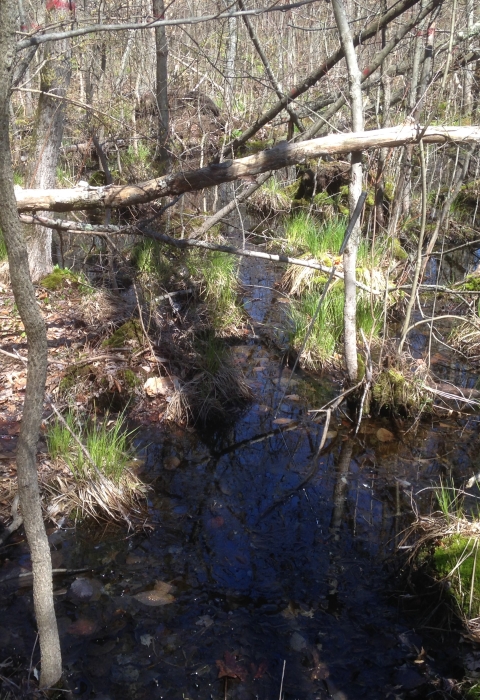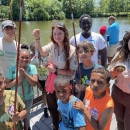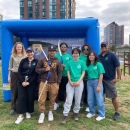Visit Us
National wildlife refuges offer us all a chance to unplug from the stresses of daily life and reconnect with our natural surroundings.
Great Swamp National Wildlife Refuge is located only 26 miles west of New York City’s Times Square. It is a 12-square-mile natural oasis in an area that is mostly suburban, making the refuge an outstanding area for migrating waterfowl to stop, rest and feed on their migration. Points of interest include:
Helen Fenske Visitor Center: The visitor center features state-of-the-art exhibits showcasing refuge wildlife, habitats, history, and recreational opportunities. The visitor center also houses the Friends of Great Swamp NWR Nature Shop. The Friends is a non-profit, all-volunteer organization which provides support to the refuge through funding and volunteer resources. Outside, beautiful native plant gardens for birds and butterflies surround the visitor center. The half-mile Bockoven Trail leads to views of a vernal pool and the Passaic River. The Nature Detective Trail, a short self-guided woodland trail, challenges children to use their senses and explore nature up close. The visitor center is currently open on Tuesdays and Thursdays through Sundays from 10AM-4PM and is located at 32 Pleasant Plains Road, Basking Ridge, NJ 07920.
Wildlife Observation Center: located at 220 Long Hill Road, the WOC is particularly good for photography and wildlife observation. It has approximately 1½ miles of boardwalks and trails, an informational kiosk, blinds for observing wildlife, and restrooms.
Overlook Parking Area: located on Pleasant Plains Road, this parking area has two viewing scopes and offers the opportunity to see many species of birds.
Wilderness area: The eastern half of the refuge was designated by Congress as a National Wilderness Area in 1968. This was the first Wilderness Area designated on Department of Interior lands. Generally no permanent structures, motor vehicles, or motorized equipment are allowed, not even mechanized forms of transportation such as bicycles. The U.S. Fish and Wildlife Service worked hard to remove remaining traces of man such as roads, buildings and dumps. Drained wetlands were restored. The Wilderness Area provides a more primitive outdoor experience and serves as an outdoor classroom and laboratory. Hiking on approximately 8 ½ miles of trails or cross-country travel is permitted. By limiting use to foot travel, the wilderness character of this sensitive area can be preserved. Waterproof footgear is recommended during most seasons. Mosquitoes, ticks, and deer flies may be a nuisance from May to September.
Location and Contact Information
About Us
The Great Swamp National Wildlife Refuge (NWR) is one of more than 567 refuges in the National Wildlife Refuge System that is administered by the Department of the Interior's U.S. Fish and Wildlife Service. The National Wildlife Refuge System is a network of lands and waters managed specifically for the protection of wildlife and its habitat. It represents the most comprehensive wildlife management program in the world.
The Great Swamp NWR is located in Morris County, New Jersey, about 26 miles west of Manhattan's Times Square. The refuge was established by an act of Congress on November 3, 1960. Today the refuge consists of 7,853 acres of varied habitats, and the refuge has become an important resting and feeding area for more than 244 species of birds. Fox, deer, muskrat, turtles, fish, frogs and a wide variety of wildflowers and plants can be found on the refuge.
In 1966, the National Park Service designated Great Swamp NWR a registered National Natural Landmark National Natural Landmark
The National Natural Landmarks Program preserves sites illustrating the geological and ecological character of the United States. The program aims to enhance the scientific and educational value of the preserved sites, strengthen public appreciation of natural history and foster a greater concern for the conservation of the nation’s natural heritage. The program was established in 1962 by administrative action under the authority of the Historic Sites Act of 1935. The first National Natural Landmarks were designated in 1963. Today, there are more than 600 National Natural Landmarks in 48 states, American Samoa, Guam, Puerto Rico and the U.S. Virgin Islands.
Learn more about National Natural Landmark under the provisions of the Historic Sites Act of 1935. The refuge was chosen for the registry as an “exceptional example of the natural history of the United States.”
In 1967, 746 acres in the eastern portion of the present Wilderness Area were declared a Research Natural Area by the Director of USFWS. This area contains natural shrub swamp habitat and many small upland islands.
This eastern portion of the refuge, comprising 3,660 acres is managed to maintain a Wilderness character while providing habitat for wildlife. The Great Swamp Wilderness Act of 1968 established the first wilderness area wilderness area
Wilderness areas are places untamed by humans. The Wilderness Act of 1964 allows Congress to designate wilderness areas for protection to ensure that America's pristine wild lands will not disappear. Wilderness areas can be part of national wildlife refuges, national parks, national forests or public lands managed by the Bureau of Land Management.
Learn more about wilderness area designated within the Department of the Interior.
What We Do
Wildlife conservation is at the heart of the National Wildlife Refuge System . It drives everything on U.S. Fish and Wildlife Service lands and waters managed within the Refuge System, from the purposes for which a national wildlife refuge national wildlife refuge
A national wildlife refuge is typically a contiguous area of land and water managed by the U.S. Fish and Wildlife Service for the conservation and, where appropriate, restoration of fish, wildlife and plant resources and their habitats for the benefit of present and future generations of Americans.
Learn more about national wildlife refuge is established to the recreational activities offered to the resource management tools used. Using conservation best practices, the Refuge System manages Service lands and waters to help ensure the survival of native wildlife species.
Refuges deploy a host of scientifically sound management tools to address biological challenges. These tools span active water management to wilderness character monitoring, all aimed at ensuring a balanced conservation approach to benefit both wildlife and people.
Our Organization
The U.S. Fish and Wildlife Service is the premier government agency dedicated to the conservation, protection, and enhancement of fish, wildlife and plants, and their habitats. We are the only agency in the federal government whose primary responsibility is the conservation and management of these important natural resources for the American public.
Our Species
The Great Swamp National Wildlife Refuge is home to an important mosaic of different habitats, from grasslands, brushlands, mature forest, forested wetlands, marsh, ponds and streams. These habitats support a variety of wildlife species, including amphibians, insects, mammals, reptiles, songbirds, and waterfowl.
Get Involved
Whether you want to further conservation, learn more about nature or share your love of the outdoors, you’ve come to the right place. National wildlife refuges provide many opportunities for you to help your community and fish and wildlife by doing what you love.
National wildlife refuges partner with volunteers, youth groups, landowners, neighbors and residents of urban and coastal communities to make a lasting difference.
Find out how you can help make American lands healthier and communities stronger while doing something personally satisfying.
Volunteers: Gain new experiences and meet new people while helping to advance wildlife conservation. Learn about volunteer opportunities at the Great Swamp National Wildlife Refuge here.
Friends: Join neighbors in helping refuges restore habitat and expand access to green space. Learn about the Friends of Great Swamp National Wildlife Refuge here.
Landowners: Learn how you can partner with the Fish and Wildlife Service to voluntarily restore land.
Local Groups:
Find out how communities can work with refuges better for wildlife and people.
Youth: Explore paid and unpaid opportunities to learn and develop leadership skills.
Projects and Research
The majority of habitat management conducted at Great Swamp National Wildlife Refuge consists of controlling natural succession, which threatens sensitive wetland habitats and open fields with encroachment by woody vegetation such as shrubs and trees. Cutting back vegetation in these areas helps to maintain the diverse mosaic of wetland and upland habitats that wildlife depend on. Techniques include mowing, manual cutting, application of specific herbicides where necessary to limit re-growth of woody vegetation, and the use of prescribed fire.








